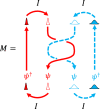Non-Abelian anyon collider
- PMID: 36333331
- PMCID: PMC9636162
- DOI: 10.1038/s41467-022-34329-y
Non-Abelian anyon collider
Abstract
A collider where particles are injected onto a beam splitter from opposite sides has been used for identifying quantum statistics of identical particles. The collision leads to bunching of the particles for bosons and antibunching for fermions. In recent experiments, a collider was applied to a fractional quantum Hall regime hosting Abelian anyons. The observed negative cross-correlation of electrical currents cannot be understood with fermionic antibunching. Here we predict, based on a conformal field theory and a non-perturbative treatment of non-equilibrium anyon injection, that the collider provides a tool for observation of the braiding statistics of various Abelian and non-Abelian anyons. Its dominant process is not direct collision between injected anyons, contrary to common expectation, but braiding between injected anyons and an anyon excited at the collider. The dependence of the resulting negative cross-correlation on the injection currents distinguishes non-Abelian SU(2)k anyons, Ising anyons, and Abelian Laughlin anyons.
© 2022. The Author(s).
Conflict of interest statement
The authors declare no competing interests.
Figures




References
-
- Leinaas JM, Myrheim J. On the theory of identical particles. Il Nuovo Cimento B Series. 1977;37:1. doi: 10.1007/BF02727953. - DOI
-
- Arovas D, Schrieffer JR, Wilczek F. Fractional statistics and the quantum Hall effect. Phys. Rev. Lett. 1984;53:722. doi: 10.1103/PhysRevLett.53.722. - DOI
-
- Bonderson P, Shtengel K, Slingerland JK. Interferometry of non-Abelian anyons. Ann. Phys. 2008;323:2709. doi: 10.1016/j.aop.2008.01.012. - DOI
-
- Nayak C, Stern A, Freedman M, Das Sarma S. Non-Abelian anyons and topological quantum computation. Rev. Mod. Phys. 2008;80:1083. doi: 10.1103/RevModPhys.80.1083. - DOI
LinkOut - more resources
Full Text Sources

